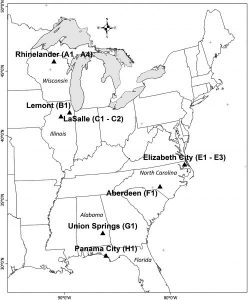Human-caused environmental degradation has created widespread ecological, economic, and social problems around the world. Phytoremediation is a sustainable solution to some of these problems. By using plants to clean up contaminated soil and water, phytoremediation combats pollution in an environmentally-friendly and aesthetically pleasing manner. Trees that are grown in short rotation cycles of 20 years or less (Short Rotation Woody Crops), specifically poplars, are suited to phytoremediation due to their genetics (poplars commonly hybridize and can transfer favorable traits through generations), physiology (e.g., rapid growth, extensive rooting, elevated water usage), and well-established prescriptions for growing them (e.g., rooted vs un-rooted cuttings, planting spacing, etc.).

Map of long‐term phytoremediation sites in the Midwest and Southeast, United States.
Researchers have bred poplars to produce superior clones that can either perform well over a variety of site conditions (generalists), or that are adapted to a particular site’s conditions (specialists). Current phytoremediation projects employ phyto-recurrent selection, a method to evaluate and select superior clones based on their response to contaminant and site conditions.
Selecting clones for superior performance in site conditions helps maximize the ecosystem services provided by a phytoremediation system. One of the main challenges for phytoremediation programs is long-term monitoring and data collection. A recent WIREs Energy and Environment review examines the ecosystem services of poplar at long-term phytoremediation sites in the Midwest and Southeast, United States, and addresses this challenge by presenting data for 5-15 year old poplars grown in phytoremediation plantings.
This work uses a case study approach to summarize data for two ecosystem services (biomass production and carbon allocation) of poplars in 15 long-term phytoremediation plantings in the United States. A total of 55 clones were tested, which to the authors’ knowledge is the greatest diversity of clones reported for long-term phytoremediation studies.
The biomass production and carbon allocation of poplars at contaminated sites was found to be similar to that of their non-contaminated counterparts. In addition, results indicate that silvicultural prescriptions (the recipe for growing a certain clone) should be tested in different site conditions and selected to further enhance ecosystem services.
Phytoremediation and associated phytotechnologies have been used successfully throughout the world to bridge the gap between ecological degradation and ecosystem restoration along urban‐to‐rural gradients. The extensive variability in above-ground biomass production and carbon sequestration illustrates the importance of long‐term monitoring and data collection at phytoremediation installations.

















